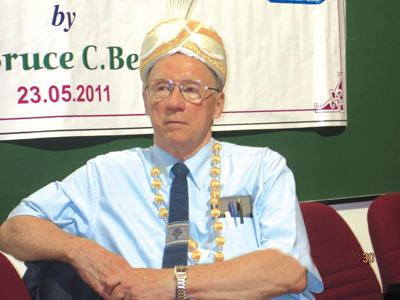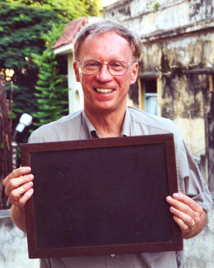|
Bruce Berndt, Professor of Mathematics, University of Illinois, Urbana-Champaign campus, and an authority on S. Ramanujan, was in the city recently and spoke at the IIT-Madras, the Institute of MatScience, Taramani, and at a meeting organised by the Ramanujan Museum & Math Education Centre (RM&MC), Royapuram, in association with the Association of British Scholars.
 Berndt garlanded and beturbanned. |
The last, a more general lecture, was preceded by tea and a welcome that made it seem more like a civic reception! Berndt was ‘crowned’ with a traditional turban and handsomely garlanded. Appreciating the gestures, he removed neither during his lecture.
Srinivasa Ramanujan, regarded as the greatest mathematician in Indian history, was born in 1887 and died in 1920. Most of his work was recorded without proofs in notebooks. According to reports available, it was in 1976, while searching through the papers of the late G.N. Watson at Trinity College, Cambridge, that George Andrew found 138 pages of Ramanujan’s work. From then, the papers have been referred to as the ‘Lost Notebooks’ of Ramanujan.
 Berndt and the Ramanujan slate. |
The lecture featured a presentation of some rare photographs, including the last photograph taken when Ramanujan was ill and under treatment. There was also a group photograph showing Ramanujan in his Convocation robes when he got his degree for research. Berndt also grabbed the audience’s attention by holding up the slate that Ramanujan used for working out some of his problems. He also showed some scans of the pages of the Notebooks and said, “The Notebooks of Ramanujan contain more results on continued fractions than what’s been done by all the mathematicians combined!”
Berndt showed the marks obtained by Ramanujan while a student at Pachaiyappah’s and wondered why Ramanujan got only 80 out of 150 in Maths in college days. It turned out that Geometry was a major portion of the syllabus and Ramanujan had no great liking for Geometry! Also shown was the content of Ramanujan’s letter to Hardy, where he had written that his findings on divergent series were “startling”!
When Berndt met Janaki Ammal, the widow of Ramanujan, some years ago, she had shown him a trunk in which several papers were stored. After his death, all these papers were handed over to Madras University, and later sent to Watson who did a great deal of research on them and, with Prof. B.M. Wilson, compiled and edited the Notebooks. When Watson passed away in 1965, the papers were handed over to Trinity College. As noted by Berndt in an interview elsewhere, “The Lost Notebooks caused as much stir in the mathematical world as Beethoven’s Tenth Symphony in the world of Western classical music.”
When asked how he was drawn into the world of Ramanujan’s Notebooks, Berndt related that after his Ph.D. at the University of Wisconsin, he joined the University of Glasgow where Prof. R.A. Rankin was a leader in number theory at the time. Rankin told him about Ramanujan’s Notebooks. Though he did not think about them then, Berndt got interested later when he had to find some answers. When he got the copies of Ramanujan’s papers from the Tata Institute of Fundamental Research, he was “thrilled” by them, he recounted.
What startled one like me who is not initiated into the world of mathematics was the sincerity with which Berndt dealt with the subject; the fact that throughout the lecture he wore the headgear and the garland, respecting the honour they represented, was admired by all.
|